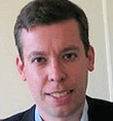How close can you get to experiencing the same feeling as your sporting heroes? If you are a soccer fan, you probably can pay a lot of money to play on the pitch at Old Trafford or the Emirates. But you will be in an empty stadium after the football season has ended, and while it will be amazing it won't be quite the same thing.
If you're a cycling fan you can ride a sportive of one of the big events and ride the same course as the professionals. The big One Day Classics now almost all have their own events on the day before the main race, and you can of course ride the Etape of the Tour de France to experience what it's like to ride a stage of the race on closed roads and with roughly the same level of rider support.
This year I got to ride something much, much better. I rode the final 106km of the Tour of Flanders just ahead of the professional riders. And it was epic. How good was it? Two weeks later, I'm still buzzing. It was one of the most memorable days I've had on a bike.
The Tour of Flanders Fan Ride might have a bit of a rubbish name (there must be something better to call it), but it consists of riding the most interesting bits of the Tour of Flanders in a group of roughly 80 riders.
I was a guest of Velusso, the Sussex based cycling club who also have a cycling café in Bruges. Their main beer supplier is Kwaremont, who are a big sponsor of the Tour of Flanders, and through them they are able to get spaces on the Fan Ride. In future years they will be dealing directly with the race organisers and will be running a weekend trip for those who want to ride in the event.
We started the day early on Sunday in Bruges and drove through pouring rain to Oudenaarde, which is where the Ronde van Vlaanderen finishes. The forecast hadn't predicted rain until much later in the day and there was a certain amount of concern in my mind about riding on wet cobbles, given I had barely encountered dry ones before (I'd ridden a few sections of pave while reconnoitring a Tour de France route in Belgium but nothing serious).
But by the time we arrived in Oudenaarde around 7.45am the rain had abated, and after a slightly tricky time finding the right car park we were getting registered and changed in the PIVA centre, of which more later. We pinned our race numbers onto our official RvV Fun Ride jerseys (very smart black and yellow Velusso jerseys which all riders were required to wear) and sensible people went through their information pack and found the sticker to put on their top tube which showed where all the climbs and cobbled sections would be on the day. Stupid people like me didn't notice the sticker until they looked through their information pack after the ride.
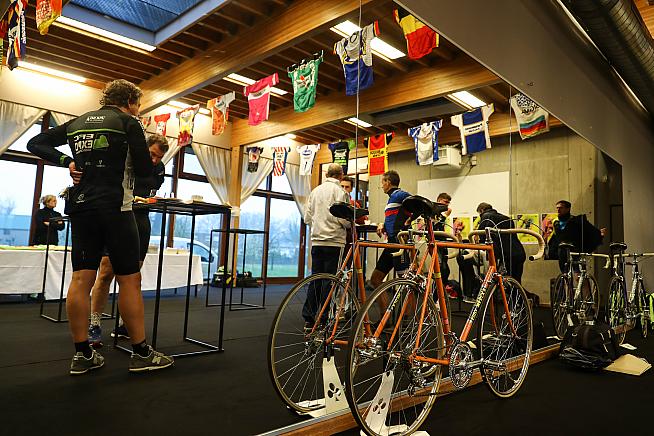
The organisers had laid on a light breakfast, but it was more of a cheese and ham snack than a full-blown carb load. There was a briefing about what to expect from the ride (in English as well as Flemish) in a room with lots of vintage bikes from famous Belgian riders and their jerseys. We then headed to the Markt (market square) of Oudenaarde. Here we were officially presented as teams up on a big stage and our team captains were interviewed while baffled locals wandered past in search of a morning croissant or baguette. This took an hour and it was a good thing it was dry and not too cold. I'm not sure the whole thing added much to my day and I would definitely have rather had an extra hour in bed!

At 9.30 we gathered on the start line behind the Fun Ride lead car. It would be fair to say that the majority of participants were skinny, white middle-aged men. I am pretty sure that of 80 riders only two were female. The local town crier in all his finery made a short speech and then fired a starting pistol and we were off, cheered on by a very small number of people who I assume were family members of the other riders.

The early pace was pretty gentle, spinning along at around 25km/h which in a peloton is easy to sustain and clearly a few people found frustrating being controlled by the lead car. We rode 18km north east on flat roads until we hit the Laange Munte, the first section of cobbles on the ride.
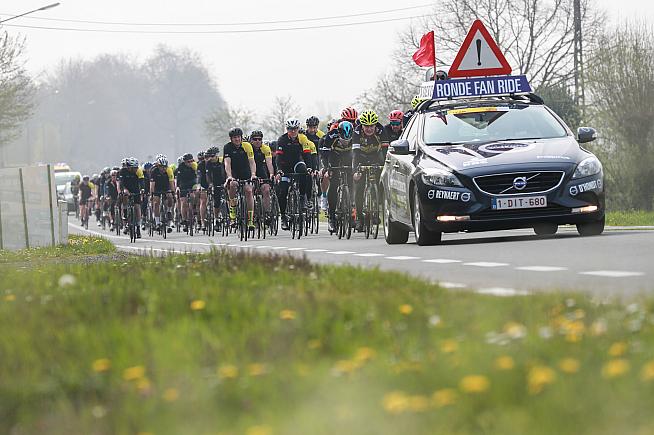
I had been expecting to find the cobbles to be a significant challenge. To my surprise and delight I actually took to them like a duck to water. Perhaps it is years of riding along the potholed roads of north London but I actually didn't find the cobbles nearly as challenging as people had warned. Maybe I should send a thank you letter to Islington and Camden councils' roads department for their inadvertent training regime. Staying in a pretty high gear and only keeping a light grip on my handlebars, I found myself passing fellow riders and perhaps even achieving the legendary 'float' over the top of the cobblestones.
There then followed three more cobbled sections, the Lippenhovestraat after 26km, the Paddestraat after 28km and the Haaghoek after 37km before after 40km the first climb of the day. This was unfortunately where I discovered that I had a problem with my lowest gears so that if I went into either the 27 or 29 of my cassette that the chain was jumping into the space between the wheel and the cassette. I was brought to a swift halt half way up the Leberg climb and found myself pushing up and cursing my luck. I would have to ride the rest of the day in no smaller than a 25, which was not an ideal position given my lack of early season fitness.
The next climb was the Berendries after 44km and shortly afterwards we pulled in to a feed station in Brakel. There were the obligatory bananas plus Belgian waffles and fruit and sweets and chocolate chunks, which seemed to please most of our parties. The less said about the toilets the better... I am not sure the two female riders were delighted to find themselves queuing in the same room as men using the urinals. The Velusso group all seemed pretty happy and to be enjoying themselves. James Bowtell, the Velusso founder, did tell us that when he did the same event the previous year it had been cold and driving rain and the mood at the feed station had been slightly different 12 months earlier.
We rode on and there four climbs in quick succession, the Ronestraat after 55km, the Kanarieberg after 60km, the Taaienberg after 65km and the Kruisberg after 77km. After each climb we were slowed down to allow the slower riders to catch up, although I gather some of the group towards the back were re-routed away from the Kruisberg to ensure that they didn't get caught up by either the women's or men's pro race. I somehow was usually in the front 30 so got to ride the full route.
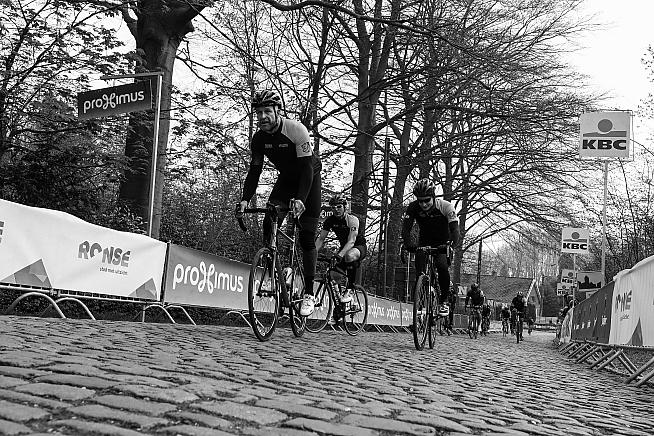
At Berchem we stopped to watch the men's pro race go past, which as usual with most cycle races involved standing around for a while before they flashed past in 20 seconds and it was impossible to work out who was doing well or badly. We waited five minutes and then we were setting off to follow the pros (who were doing multiple loops of the Oude Kwaremont).
With only 24km left to ride my legs were feeling good but I did also know that I had two of the most famous climbs in Belgian cycling to come. First up was the Kwaremont at the 87km point, which is the longest section of cobbles on the ride - 2.2km at an average of 4.2%. It is pretty narrow and the steepest section is 11% but the great thing was that the crowds were roaring us on, which means there is no way that you can consider stopping.
I have no idea who they thought we were, but groups of people ran with beers in hand to cheer us on and encourage us up the climb. It was a fantastic feeling, although I think I experienced extra cheers because one of the women on the ride was behind me and lots of people were shouting "Come on the girls" (sometimes in English but mostly in Flemish). She overtook me with about 100 metres to go and I dug deep to come back and overtake her just before the summit.
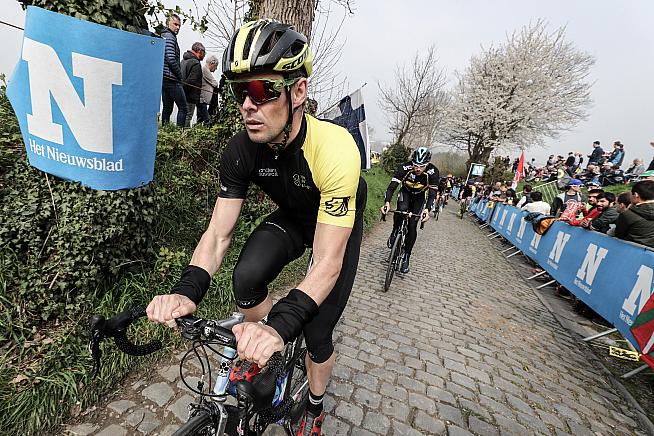
Just 5km after the Kwaremont is the Paterberg, the steepest of the cobbled climbs in the Tour of Flanders and actually one whose history is somewhat artificial. In 1986 the farmer on whose land the climb is located was so jealous of the attention and income that the farmer who owns the Kwaremont was getting that he decided to create his own cobbled climb in competition. The Paterberg is a short, steep cobbled climb of 400m at an average of 12.5% and a maximum of 20%.
With the crowds perhaps 15 deep in most places and shouting us up, even though at times I was somewhat tempted to put my foot down there is no way I could have lived with the humiliation. Instead I battled up alongside my Kwaremont female rider, who pipped me by half a bike wheel at the top to make it 1-1 in the climbing battle. We shook hands at the top and congratulated each other on making it up together.
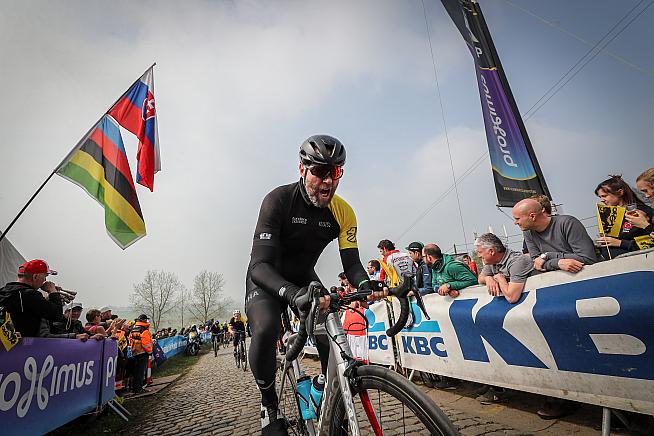
Again we regrouped behind the lead car and were told that for the final 14km we were free to race each other to the finish line. We started off as a large peloton but the group soon fractured as the stronger riders put the hammer down. I held on at an average of just over 40km/h until 3km to go when my elastic snapped and I watched most of my Velusso team mates disappear into the distance (to be fair, they are much better riders than me and James is an ex-pro and had a world record for endurance riding). At 2km another group of riders caught me up and I latched onto the back and recovered a little, until down the home straight with 200 metres to go I launched my attack as fans banged the advertising boards on the side of the barriers and cheered us home. Fortunately none of that group caught me and I crossed the line with an enormous smile on my face.
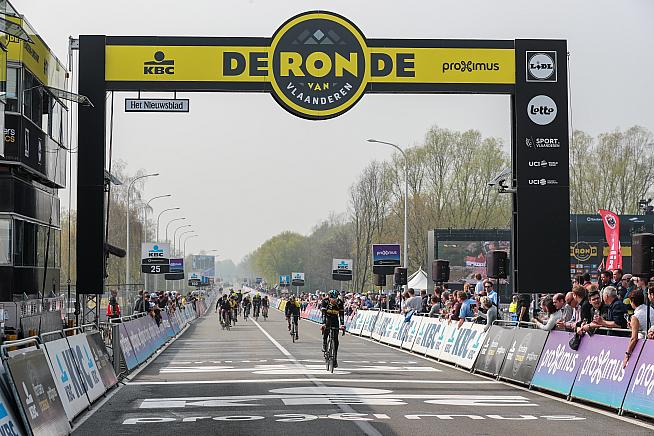
We took some quick team photos before heading back to the PIVA centre to change, have a quick Kwaremont before heading to the VIP Flanders Classic Club on the finish line to watch the finish of the women's and men's races. This was perhaps the worst part of the day with about 60 men all in a hurry to have a shower in a tiny changing room. The American riders were particularly horrified as it was a communal shower (I think they were abolished in about 1963 in the US) with no individual cubicles and there was also no soap. I'd brought soap, shampoo and a towel but several riders had assumed the VIP experience would include things to wash with! There were definitely a few people not so happy about this and I guess it will be something they look at next year.
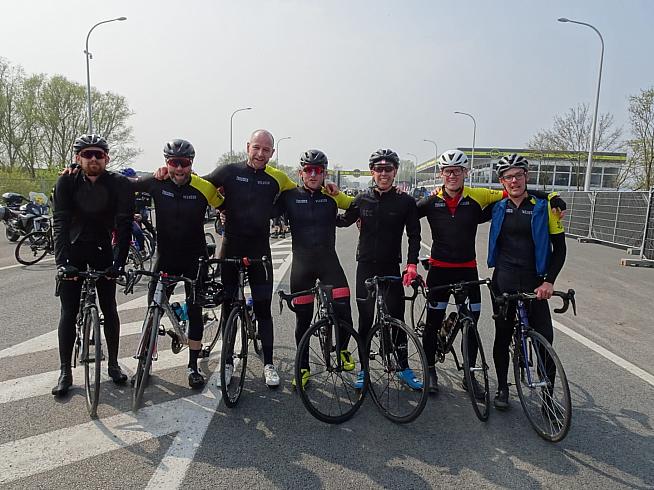
We headed to the finish line where the free Kwaremont was flowing and I was highly impressed by the mix of people watching the cycling. There was an unusual gender balance by comparison with most cycling events I have attended with plenty of people in their 20s all seriously watching and discussing the riders and tactics. In 2010 when Fabian Cancellara won the Tour of Flanders, 74% of the Belgian population watched the race on the television - I assume the other 26% were out beside the roads cheering on Spartacus. It is no exaggeration to say that the Tour of Flanders is the Super Bowl of Belgium, and there was a real buzz to the finish, albeit most spectators were pretty disappointed that the solo breakaway of Alberto Bettiol was not chased down by the elite group of riders who couldn't agree to work together.
With the race finished we headed back to Bruges, driving through a biblical storm which meant we could barely see out of the windscreen. Had that weather arrived three hours earlier the ride would have been somewhat different and a lot more testing as I suspect the ascent of the Paterberg would have been like going up a cobbled river.
All in all, this was a fantastic day. Total climbing on the day was officially 944 metres (3,097 feet), although my Garmin recorded it at 1,203 metres with 104.68km covered in 3 hours and 53 minutes of riding time. When I spoke to my wife that evening I told her it was my second best day on a bike ever, only beaten by my first Marmotte. The experience of riding the key climbs of the Tour of Flanders in front of so many supporters really is hard to replicate anywhere else in the world. I'd thoroughly recommend it to anyone.
Velusso will be running annual Tour of Flanders Fun Ride weekends, including accommodation, transport to/from the finish line, a 50km Saturday prep ride and meals.
0 Comments

